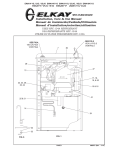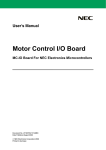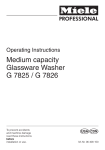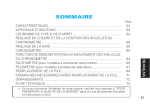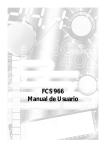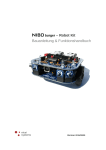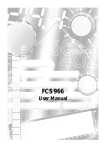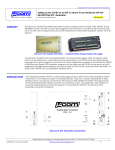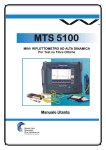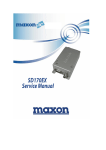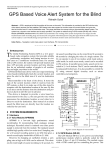Download QIC Core
Transcript
QIC PROCESSOR CORE V16 U SER ' S M ANUAL © QUANSER CONSULTING INC., 2002 QIC How to contact Quanser Consulting: (905) 940-3575 Telephone (905) 940-3576 Facsimile 80 Esna Park Drive Markham, ON Canada L3R 2K8 Mail http://www.quanser.com/qic/ Web mailto://[email protected] mailto://[email protected] mailto://[email protected] Information about QIC Support for QIC General information User's Manual QIC is a trademark of Quanser Consulting, Inc. PIC, and PIC16F877 are a trademarks of Microchip Technology Inc. Other brands and their products are trademarks or registered trademarks of their respective holders and should be noted as such. © 2002 Quanser Consulting Inc. All rights reserved. This work may not be translated or copied in whole or in part without the written permission of the copyright holder, except under the terms of the associated software license agreement. No part of this manual may be photocopied or reproduced in any form. The use of general descriptive names, trade names, trademarks, etc. in this publication, even if the former are not especially identified, is not to be taken as a sign that such names as understood by the Trade Marks and Merchandise Marks Act, may accordingly be used freely by anyone. Printed in Canada. © Quanser Consulting Inc., 2002 Indexes - Page II QIC TABLE OF CONTENTS 1 INTRODUCTION ........................................................................................................1 2 QIC PROCESSOR CORE ...........................................................................................2 2.1 Processor Core Features........................................................................................3 2.2 Processor Core Pin Names.....................................................................................4 2.3 Processor Core Pin Locations...............................................................................4 3 QIC PROCESSOR CORE ACCESSORIES ............................................................10 3.1 In-Circuit Serial Programming Hardware........................................................10 3.1.2 High-Voltage Programming...........................................................................11 3.1.2.1 High-Voltage Programming Procedure...............................................................12 3.1.3 Low-Voltage Programming............................................................................12 3.1.3.1 Low-Voltage Programming Procedure................................................................12 3.2 On-Board Serial Support.....................................................................................15 3.2.1 RS232 Compatible Serial Port.......................................................................16 3.2.2 QIC-Link Serial Port......................................................................................17 4 SUPPORT SOFTWARE ............................................................................................20 4.1 Using the QIC Loader..........................................................................................20 4.1.1 High Voltage Programming............................................................................21 4.1.2 Low Voltage Programming............................................................................21 4.2 Using the QIC Bootloader....................................................................................23 5 SCHEMATICS ............................................................................................................25 5.1 QIC Processor Core – V16...................................................................................26 © Quanser Consulting Inc., 2002 Indexes - Page III QIC FIGURE INDEX Index of Figures Figure 1. The QIC Processor Core. ....................................................................................2 Figure 2. The QIC Processor Core – Pin names and functions. .........................................5 Figure 3. In-circuit serial programming support circuitry. ...............................................11 Figure 4. Serial pin locations. ...........................................................................................13 Figure 5. Serial programming and connection setup details. ...........................................14 Figure 6. Serial interface logical diagram. .......................................................................15 Figure 7. The serial interface circuitry. ............................................................................16 Figure 8. Serial interface to PC wiring. ............................................................................16 Figure 9. QIC Link network connections. ........................................................................18 Figure 10. "Star" network topology of QIC Link. ............................................................19 Figure 11. QIC Loader window. Select a file by clicking on Browse. .............................20 Figure 12. Programmer error message. .............................................................................22 Figure 13. Typical error message encountered during programming. .............................22 Figure 14. PIC Downloader interface window. ................................................................24 © Quanser Consulting Inc., 2002 Indexes - Page IV QIC INDEX OF TABLES Index of Tables Table 1. Pinout description for pins 1 - 18. Table 2. Pinout description for pins 19 - 36 Table 3. Serial / Programming port connections. Table 4. QIC Link serial port connections. Table 5. High-Voltage programming support connections. © Quanser Consulting Inc., 2002 6 7 8 8 9 Indexes - Page V QIC PROCESSOR CORE MANUAL 1 INTRODUCTION The QIC suite of development components is aimed at simplifying the development of microcontroller-based applications. By integrating several commonly used functions into one convenient package, development time is greatly reduced. The user can quickly commence development of the external interfaces and the software, rather than spend time building the base microcontroller system. Using the QIC system as a reference design can greatly reduce implementation time of your designs. The QIC system consists of two main hardware components. The first is the QIC Processor Core. This component hosts the microcontroller and the associated components to facilitate communications and programming. The second component is the QIC Carrier Board, which hosts an array of interfaces and signal conditioning options. Several different carrier boards are available, and are suited to different applications. Together, the two boards form an excellent reference design for many projects such as robotics, controllers, and various signal processing applications. © Quanser Consulting Inc., 2002 Introduction - Page 1 QIC PROCESSOR CORE MANUAL 2 QIC PROCESSOR CORE Based on the PIC16F87X series of microcontrollers, the QIC Processor Core offers all the features of the processor, plus the added ease of interfacing, programming and prototyping. Designed to fit into a standard prototyping breadboard, the QIC allows the user to design interface circuitry on a breadboard to quickly test new ideas. Figure 1. The QIC Processor Core. © Quanser Consulting Inc., 2002 QIC Processor Core - Page 2 QIC PROCESSOR CORE MANUAL 2.1 PROCESSOR CORE FEATURES Designed around the PIC16F877 microcontroller, the QIC Processor Core allows the user to take advantage of the vast amounts of freely available source code on the Internet. No special tools are required to program the processor core – the programming support hardware is already included. The user just needs to use the QIC Loader to download a new program. The code can be compiled using any of the available compilers for the PIC16FXXX series of microcontrollers. Based on the Microchip PIC16F877 8K Flash program memory 368 bytes RAM 256 bytes EEPROM memory 14 hardware interrupts 3 hardware timers 10 bit A/D (8 channels) 10 bit PWM (2 channels) RS 232 compatible serial port – connects directly to the PC In-circuit serial programming support hardware built in On board reset switch. Single +5V supply required © Quanser Consulting Inc., 2002 QIC Processor Core - Page 3 QIC PROCESSOR CORE MANUAL 2.2 PROCESSOR CORE PIN NAMES Figure 2 shows the location of the pins and their associated names for the QIC Processor Core. For detailed information on the PIC microcontroller, programming, and special function details, refer to the Microchip website, at http://www.microchip.com. Document number 30292c provides detailed programming information on the PIC16F87X series of microcontrollers. In most instances, the signal from the microcontroller is directly available on the pins of the QIC Processor Core. Please refer to the schematics section for details on this. 2.3 PROCESSOR CORE PIN LOCATIONS Figure 2 also shows the pin locations and their numbering. Note how the pins are offset in their alignment to prevent the QIC Processor Core from being inserted incorrectly. The pins are numbered consecutively, from 1, counter clockwise from the top left. © Quanser Consulting Inc., 2002 QIC Processor Core - Page 4 QIC PROCESSOR CORE MANUAL Serial / Programming port RTS PIN 36 GND DTR CTS TXD RXD PIN 1 RB0/INT VCC RB1 RD7/PSP7 RD6/PSP6 RB2 RB3/PGM RD5/PSP5 RB4 RD4/PSP4 RB5 RD3/PSP3 RD2/PSP2 RB6/PGC PB7/PGD RD1/PSP1 RD0/PSP0 PE0/RD/AN5 PIN 28 JP1 (Programming Jumper) PIN 10 RE1/WR/AN6 RE2/CS/AN7 RA0/AN0 CLK RC7/RX/DT RA1/AN1 RA2/AN2/VREF- RC6/TX/CK RA3/AN3/VREF+ RC4/SDI/SDA RA4/T0CKL RC3/SCK/SCL RC2/CCP1 RC5/SD0 RA5/SS/AN4 GND RC1/T1OSO/CCP2 JP2 High-Voltage Programming Header GND QICRx QICTx VHVP GND RC0/T1OSO/T1CKI PIN 19 QIC Link Serial Port Figure 2. The QIC Processor Core – Pin locations and functions. © Quanser Consulting Inc., 2002 QIC Processor Core - Page 5 QIC PROCESSOR CORE MANUAL QIC Core Pin Descriptions – Pins 1 – 18 QIC Pin Number Pin Name Alternate Names 1 2 3 4 RB0 RB1 RB2 RB3 INT Also serves as an external interrupt pin. PGM Applying +5V volts will allow low voltage programming when the configuration bits are set appropriately. 5 6 7 RB4 RB5 RB6 PGC 8 RB7 PGD Interrupt-on-change pin. Also used as the serial programming clock Interrupt-on-change pin. Also used as the serial programming data Description PORTB is a bi-directional I/O port. The pins on this port can be programmed to use the internal weak pull ups. PORTE is a bi-directional I/O port. 9 RE0 /RD, AN5 Read control for the slave port, or analog input 5 10 RE1 /WR, AN6 11 RE2 /CS, AN7 Write control for the slave port, or analog input 6 Chip select for the slave port, or analog input 7 PORTA is a bi-directional I/O port 12 13 14 RA0 RA1 RA2 AN0 AN1 AN2, VREF- 15 RA3 AN3, VREF+ 16 RA4 T0CKI 17 RA5 /SS, AN4 18 GND GND Analog input 0 Analog input 1 Analog input 2, or negative analog reference voltage Analog input 3, or positive analog reference voltage Clock input to Timer0 timer / counter. (open drain type) Analog input 4, or slave select for the synchronous serial port Ground / power return pin Table 1. Pinout description for pins 1 - 18. © Quanser Consulting Inc., 2002 QIC Processor Core - Page 6 QIC PROCESSOR CORE MANUAL QIC Core Pin Descriptions – Pins 19 – 36 QIC Pin Number Pin Name 19 20 RC0 RC1 21 RC2 22 RC3 23 RC4 24 25 RC5 RC6 26 RC7 27 CLK Alternate Names Description PORTC is a bi-directional I/O port T1OSO, T1CKI Timer1 oscillator output or Timer1 clock input T1OSI, CCP2 Timer1 oscillator input or Capture 2 input/Compare 2 output/PWM2 output Capture 1 input, Compare 1 output/PWM1 CCP1 output Synchronous serial clock input/output for SPI SCK, SCL and I2C modes SPI data in in SPI mode, or data I/O in I2C SDI, SDA mode SDO SPI data out in SPI mode USART Asynchronous transmit or TX, CK synchronous clock USART Asynchronous receive or RX, DT synchronous data Processor clock source. This is an external clock (20MHz) for use with external peripherals PORTD is a bi-directional I/O port. It also serves as the parallel slave port when interfacing to a microprocessor bus 28 29 30 31 32 33 34 35 RD0 RD1 RD2 RD3 RD4 RD5 RD6 RD7 36 VCC +5VDC Power Table 2. Pinout description for pins 19 - 36 © Quanser Consulting Inc., 2002 QIC Processor Core - Page 7 QIC PROCESSOR CORE MANUAL Serial / Programming Port Pin Descriptions Pin Number 1 2 3 4 5 6 Pin Name Description RxD PC Receive data line (RS232 level). Data from the QIC is transmitted on this line to the PC TxD PC Transmit data line (RS232 level). Data is received by the QIC on this line from the PC DTR PC Data Terminal Ready line. Used for programming purposes PC Clear To Send line. Used for CTS programming purposes RTS PC Ready To Send line. Used for programming purposes GND Ground line Table 3. Serial / Programming port connections. QIC Link Pin Descriptions Pin Number Pin Name Description 1 QIC Link Rx Data transmitted from other QIC modules is sent to the serial port, bypassing the QIC (RS232 level). This data is seen by the host only. 2 QIC Link Tx Data received at the serial port is retransmitted via this pin to other QIC modules (RS232 level). The data appears as if it came from the host directly. 3 GND Ground connection. Table 4. QIC Link serial port connections. © Quanser Consulting Inc., 2002 QIC Processor Core - Page 8 QIC PROCESSOR CORE MANUAL High Voltage Programming Pin Descriptions Pin Number 1 2 Pin Name Description +12VDC input for high-voltage VHVP programming. Ground connection for high-voltage GND programming Table 5. High-Voltage programming support connections. 3 QIC PROCESSOR CORE ACCESSORIES To simplify the development process, the QIC Processor Core has built in serial support and in-circuit programming support. This section has detailed information on these two interfaces. 3.1 IN-CIRCUIT SERIAL PROGRAMMING HARDWARE To make programming of the QIC Processor Core easier, the circuitry required for incircuit serial programming has been included directly on the board. The circuitry is designed to allow for in-circuit serial programming when required, but to leave the programming pins available for other functions when the device is not being programmed. To enable this dual configuration, a jumper, JP1 is used to select between programming mode and normal operation. In the event that the programming pins (RB6 and RB7) are not required for the user's application, the jumper can be left in place without affecting the normal operation of the system. In effect, installing the jumper (JP1) connects the pins RB6 and RB7 to the in-circuit serial programming hardware. Removing the jumper connects pin RB6 to pin 7 of the QIC core, and pin RB7 to pin 8 of the QIC core. Figure 3 shows the circuit details that achieve this functionality. © Quanser Consulting Inc., 2002 QIC Processor Core - Page 9 QIC PROCESSOR CORE MANUAL VCC R3 10k U4A 1 2 VCC SN7407 R4 10k VCC JP2 1 2 U4B 3 VCC TX DTR CTS RTS GND SN7407 +12V DP1 R5 10k R8 10k R1 U4C 6 5 U3 12 13 VCC SN7407 PC R6 10k RB7X U4D 9 8 VCC SN7407 R7 10k U4E 11 10 U4F 13 JP1 1 2 SN7407 Program RB6X 2 1 5 3 6 11 10 9 7 X0 X1 X Y0 Y1 Y Z0 Z1 Z 100 1 1 2 3 4 5 6 R2 10k 14 MCLR S1 MA152WKCT-ND 15 RB7 RB7 4 RB6 RB6 RESET C1 1uf 2 J1 4 INH A B C VEE MC14053B 12 QIC Programmer SN7407 Figure 3. In-circuit serial programming support circuitry. 3.1.1 3.1.2 HIGH-VOLTAGE PROGRAMMING Programming voltage is applied to header JP2 (see Figure 5). +12VDC should be applied to pin 1, and the ground for the external source should be connected to pin 2. Refer to Figure 3 for details. Applying the voltage at this connector supplies the required high voltage signal to put the PIC16F877 into the programming mode. The voltage for high voltage programming can be obtained from any regulated external power source. Using the QIC Loader, the user can quickly program the device with their own code. In addition, the user can write their own programmer to use the on-board in-circuit serial programming hardware. Microchip has documents detailing in-circuit serial programming of the 16F877 processor. Please note that the PIC16F877 will be put into programming mode when both RB6 and RB7 are held low, and MCLR is brought up to the required high voltage programming voltage. This condition is most easily obtained by setting up the high voltage programming voltage, holding RB6 and RB7 low, and waiting for the user to © Quanser Consulting Inc., 2002 QIC Processor Core - Page 10 QIC PROCESSOR CORE MANUAL press the reset button on the QIC Processor Core. This procedure guarantees that when the reset button is released the PIC16F877 will go into the program mode. 3.1.2.1H I G H -V O LT A G E P R O G R A M M I N G P R O C E D U R E . Install a jumper on JP1, shorting the pins together. Apply +12V to JP2. +12VDC should be on pin 1, ground (GND) on pin 2. Connect the programming cable to J1, the programming/serial port. Start the programming software and follow the directions. 3.1.3 LOW- VOLTAGE P ROGRAMMING With the configuration register of the PIC16F877 set appropriately, it is possible to program the device using only +5VDC. By default, when fully erased, the PIC16F877 will allow low-voltage programming (LVP)1. To put the PIC16F877 into low-voltage programming mode, the user will need to apply +5VDC to the PGM pin (RB3), or pin 4 of the QIC Processor Core (see Figure 5). Note that when in this mode, RB3 cannot be used for any other purpose. In effect, this pin is lost to the user under software control. The only function of the pin is to put the PIC16F877 into low-voltage programming mode when the LVP bit of the configuration register is set2. As with the high-voltage programming mode, the user can either use the QIC Loader, or write their own software to program the device. Microchip has documents detailing in-circuit serial programming of the 16F877 processor. Please note that the PIC16F877 will enter programming mode when both RB6 and RB7 are held low, and +5VDC is applied to the PGM pin (pin 4 of the QIC core). With these conditions present, pressing the reset button will guarantee that the PIC16F877 will enter programming mode when the reset switch is released. 3.1.3.1L O W -V O LT A G E P R O G R A M M I N G P R O C E D U R E Install a jumper on JP1, shorting the pins together. 1 Please consult the Microchip document,"EEPROM Memory Programming Specification" document number 30262c (30262c.pdf, www.microchip.com ) 2 Note that if the LVP (low voltage programming) bit is cleared – disabling LVP – this method of programming will no longer be available. The user will have to resort to high-voltage programming. © Quanser Consulting Inc., 2002 QIC Processor Core Accessories - Page 11 QIC PROCESSOR CORE MANUAL Apply +5VDC to the PGM pin (pin 4 of the QIC core). A good source for this is the power going to pin 36, VCC. Connect the programming cable to J1, the programming/serial port. Start the programming software and follow the directions. Serial / Programming port RXD TXD DTR CTS RTS GND PIN 1 Programmer HVP Enable RESET JP1 (Programming Jumper) Q PIC16F877 20MHz QICTx QICRx GND GND VHVP RS232 JP2 High-Voltage Programming Header QIC Link Serial Port Figure 4. Serial pin locations. © Quanser Consulting Inc., 2002 QIC Processor Core Accessories - Page 12 QIC PROCESSOR CORE MANUAL Serial / Programming port QIC pin 1 VCC (+5VDC) J1 pin 1 PGM, pin 4 (low-voltage mode) Programmer HVP Enable RESET Short this jumper (JP1) Q PIC16F877 20MHz RS232 JP2 (GND, +12V) Apply programming voltage here. (High – voltage mode) Figure 5. Serial programming and connection setup details. © Quanser Consulting Inc., 2002 QIC Processor Core Accessories - Page 13 QIC PROCESSOR CORE MANUAL 3.2 ON-BOARD SERIAL SUPPORT The on-board serial interface is shown in logical format in Figure 6. With an external connection to J1, the serial port connector, the device will be able to communicate with the QIC Processor Core. Signals transmitted from the PC (TxD) are received by the PIC on RC7, which is connected directly to the microcontroller's USART. Using the USART allows for the greatest flexibility in serial support, while minimizing the required software overhead. 1 3 PIC Tx PIC Tx (RC6 pin 25) 2 TTL > RS232 J1 PC RxD PC TxD 1 2 3 4 5 6 GND PIC Rx PIC Rx (RC7 pin 26) RS232 > TTL GND PC J2 Tx Rx GND 1 2 3 QICLink Rx QICLink Tx RS232 > TTL QICLink GND TTL > RS232 Figure 6. Serial interface logical diagram. Similarly, serial data is shifted out of the USART on RC6, and is sent to the PC's RxD pin on the serial port. The serial interface uses a combined RS232 to TTL / TTL to RS232 converter to provide the proper signal levels for the PC and the PIC16F877. The QIC Link port echoes the serial data received at J1 on connector J2.By connecting additional devices, to the QIC Link port, they will also be able to communicate with the host PC (or host device). The full serial interface schematic is shown in Figure 7. © Quanser Consulting Inc., 2002 QIC Processor Core Accessories - Page 14 QIC PROCESSOR CORE MANUAL J1 1 2 3 4 5 6 RxD TxD RC6 DP2 MA152WACT-ND RC7 V+ V- PC J2 1 2 3 U1 QICT QICR 13 8 11 10 1 3 QICLink C7 1 uf R1 IN R2 IN T1 IN T2 IN C1+ C1 - R1 OUT R2 OUT T1 OUT T2 OUT C2+ C2 - 12 9 14 7 4 5 C5 1 uf C8 1 uf C6 1 uf VCC MAX232CWE RS232 Interface Figure 7. The serial interface circuitry. 3.2.1 RS232 COMPATIBLE SERIAL PORT Details of the connections for the serial port interface are shown in Figure 8. These connections will need to be made in order to connect the PC to the QIC Processor Core. The connections shown are for a female DB9 connector. Note that only the signals TxD, RxD and GND are required for serial communications. The other lines are required for in-circuit serial programming only, but are shown here for reference. Referring to Figure 7, the MAX232CWE IC takes care of the conversions between TTL and RS232. All signals at connector J1 are expected to be at standard RS232 levels. RB0 RB1 RB2 RB3 RB4 RB5 RB6 RB7 RE0 RE1 RE2 RA0 RA1 RA2 RA3 RA4 RA5 GND QIC Motherboard Programmer PIC16F877 20MHz RS232 HVP Enable RESET 1 6 To PC 1 6 2RxD 7RTS 3TxD 8CTS 4DTR 9 5GND DB-9 Pins Signal Description --------------------------------------------2 (1)RxD Transmit to PC 3 (2)TxD Receive from PC 4 (3)DTR Data In from PC 8 (4)CTS Data Out to PC 7 (5)RTS Clock from PC 5 (6)GND Ground VCC RD7 RD6 RD5 RD4 RD3 RD2 RD1 RD0 CLK RC7 RC6 RC5 RC4 RC3 RC2 RC1 RC0 DB9 Figure 8. Serial interface to PC wiring. When writing software to use the serial port, the user must be careful to specify RC6 for transmitting serial data, and RC7 for receiving serial data. Some compilers allow for software implemented serial ports on any I/O pins of the device. The user will also need © Quanser Consulting Inc., 2002 QIC Processor Core Accessories - Page 15 QIC PROCESSOR CORE MANUAL to take care of the RS232 to TTL level conversion. RS232 level signals should not be directly applied to any pins except the serial port interface or the QIC Link interface. 3.2.2 QIC- LINK SERI AL PORT The QIC Link serial port is intended to facilitate multi-device communications. The topology of the communication network is "host-to-slave". What this means is that the host PC can communicate with any of the QIC Processor Core modules. The QIC cores can in turn talk to the host PC. Refer to Figure 6 and Figure 7 for details on the implementation of this circuit. Figure 9 details the network connections necessary to link several QIC Processor Core boards together. Although it appears that data flows through the previous QIC core in the network chain, this is not the case. QIC cores connected in this manner will only be able to talk directly to the host PC. Other QIC cores will not see the serial communications data. However, every QIC on the network will see serial communications sent from the host PC. For this reason, the user will need to implement some type of protocol to manage the network traffic. Each QIC Processor Core on the network will need to be assigned an address so that it can determine if the data being sent is intended for it. Many different methods exist for implementing this type of network negotiation. The exact type of protocol used will depend on the actual application requirements. © Quanser Consulting Inc., 2002 QIC Processor Core Accessories - Page 16 QIC PROCESSOR CORE MANUAL Host PC Serial port connection QIC Core 1 QIC Core 2 QIC Core 3 QIC Core 4 QIC Link connection Figure 9. QIC Link network connections. QIC Core 1 QIC Core 2 QIC Core 4 QIC Core 3 Figure 10. "Star" network topology of QIC Link. © Quanser Consulting Inc., 2002 QIC Processor Core Accessories - Page 17 QIC PROCESSOR CORE MANUAL © Quanser Consulting Inc., 2002 QIC Processor Core Accessories - Page 18 QIC PROCESSOR CORE MANUAL 4 SUPPORT SOFTWARE Programming of the QIC Processor Core can be achieved in a variety of ways. Using the included support software such as the QIC Loader and the QIC Bootloader, the user can quickly develop and test new applications. Depending on the end use of the application, the user may choose the QIC Loader approach over the QIC Bootloader approach or vise-versa. 4.1 USING THE QIC LOADER The QIC Loader approach allows programming of the QIC Processor Core while it is still in the user's circuit. Using the loader approach is the more traditional of the programming methods in that the programmer erases the entire memory contents of the device and rewrites it with the user's new code. Using this approach, all areas of the memory space can be modified; code memory, data EEPROM memory, and configuration memory. Since this method allows setting of the code protection bits in the configuration memory registers, it is usually the preferred method for final product deployment. Figure 11. QIC Loader window. Select a file by clicking on Browse. Programming can be accomplished using either high-voltage or low voltage mode. Depending on the programming mode selected, follow the appropriate procedure below. © Quanser Consulting Inc., 2002 Support Software - Page 19 QIC PROCESSOR CORE MANUAL 4.1.1 HIGH VOLTAGE PROGRAMMING Install a jumper on JP1, shorting the pins together. Apply +12V to JP2. +12VDC should be on pin 1, ground (GND) on pin 2. Connect the programming cable to J1, the programming/serial port. The other end of the cable should connect to the serial port of the PC. Apply power to the QIC Processor Core. Start the QIC Loader and select an Intel Hex formatted file to load. Make sure that the correct serial port is selected. The default port is COM1. Select a different one by selecting Setup -> Serial Port and selecting from the available choices. Click the Write button to begin the programming process. Follow the directions on the screen. The Reset button referred to on the screen is the reset button on the QIC Processor Core. A dialog will appear confirming the success or failure of the programming procedure. 4.1.2 LOW VO LTAGE PROGRAMMING Install a jumper on JP1, shorting the pins together. Apply +5VDC to the PGM pin (pin 4 of the QIC core). A good source for this is the power going to pin 36, VCC. Connect the programming cable to J1, the programming/serial port. The other end of the cable should connect to the serial port of the PC. Apply power to the QIC Processor Core. Start the QIC Loader and select an Intel Hex formatted file to load. Make sure that the correct serial port is selected. The default port is COM1. Select a different one by selecting Setup -> Serial Port and selecting from the available choices. Click the Write button to begin the programming process. Follow the directions on the screen. The Reset button referred to on the screen is the reset button on the QIC Processor Core. © Quanser Consulting Inc., 2002 Support Software - Page 20 QIC PROCESSOR CORE MANUAL A dialog will appear confirming the success or failure of the programming procedure. In most cases, the programming will complete successfully. However, there are times when errors will occur. The error message shown in Figure 12 typically means that the PC cannot detect the hardware. This error will occur before the programming begins. Figure 12. Programmer error message. Typical causes of this are: Serial cable unplugged from the PC or the QIC Processor Core Wrong serial port selected in the QIC Loader Power is not applied to the QIC Processor Core. Damaged serial cable The causes listed above should be checked to remedy the problem before trying to continue. Other errors may occur during the programming procedure. The error shown in Figure 13 is indicative of a programming error. Figure 13. Typical error message encountered during programming. © Quanser Consulting Inc., 2002 Support Software - Page 21 QIC PROCESSOR CORE MANUAL Typical causes of this are: Serial communications error; check symptoms of failed hardware first. Jumper JP1 has not been installed for programming. No programming voltage applied for high-voltage programming, or PGM voltage not present for low-voltage programming. Reset button not pressed when requested by the software. Code protection bits are set in the configuration memory area. Erase the entire device before continuing. Processor is faulty or damaged. Use of the programming software is fairly straight-forward. There are additional tools for viewing the program and data memory, as well as for erasing an PIC16F877 and restoring to its default condition. 4.2 USING THE QIC BOOTLOADER The QIC Bootloader approach takes advantage of the processor's ability to reprogram its own code space. To start, a small program called the bootloader is programmed into the device using the QIC Loader. This bootloader occupies a very small portion of the code space near the top of memory. Once loaded, upon processor reset, the bootloader looks for a serial "signature" at the serial port. If it receives this signature, it then goes into the bootloading mode, otherwise, it begins executing the previously loaded user code. In the bootloading mode, an Intel Hex type file is transferred to the device using a standard serial protocol. Typically, a serial terminal program such as Hyperterminal or the PIC Downloader can be used to send a new file. The previously installed bootloader receives the code and reprograms the PIC. This method is extremely useful for rapid development of new designs. In order to use the bootloader, the bootloader code must be downloaded to the processor first. Otherwise, the bootloading will not be possible. Once the bootloader is installed, neither high-voltage programming, nor low-voltage programming will be required. For this reason, the user may wish to disable the low-voltage programming © Quanser Consulting Inc., 2002 Support Software - Page 22 QIC PROCESSOR CORE MANUAL option by setting the appropriate configuration bits. Once the bootloader code is loaded into the program memory, only the serial port connections will be required. To use the PIC Downloader, start the program and select an Intel Hex formatted file for download. Search for this file by clicking the search button, or pressing F2. Figure 14. PIC Downloader interface window. Once the file is loaded, press Write (or F4) to begin the programming process. The reset button on the QIC Processor Core should be pressed at this time. After a brief pause, the download will commence. If problems arise during the programming process, check the following list of possible causes. Make sure the serial cable is attached, and that power is applied. Be certain that the bootloader code has already been written to the device using either high-voltage or low voltage programming. Verify that the serial port and the baud rate are correct for the bootloader that is being used. © Quanser Consulting Inc., 2002 Support Software - Page 23 QIC PROCESSOR CORE MANUAL 5 SCHEMATICS The schematics provided in this section are for user reference only. The schematics are Copyright Quanser Consulting Inc. 2002. The information contained here may not be used for commercial purposes without the consent of Quanser Consulting Inc. Use of the circuitry for educational purposes only is permitted, provided that the user has purchased one QIC Processor Core for each circuit that is constructed. For information on licensing the QIC Processor Core for commercial or other purposes, please contact Quanser Consulting Inc. Quanser Consulting Inc. 80 Esna Park Drive, Units 1,2,3 Markham, Ontario Canada L3R 2R6 Tel : +1 (905) 940 - 3575 www.quanser.com mailto://[email protected] 5.1 QIC PROCESSOR CORE – V16 © Quanser Consulting Inc., 2002 Schematics - Page 24 QIC PROCESSOR CORE MANUAL TxD DTR 1 3 9 6 R5 10k VCC CTS RTS 11 13 U4A SN7407 U4B SN7407 U4C SN7407 U4D SN7407 U4E SN7407 U4F SN7407 2 4 5 8 10 12 VCC R3 10k VCC R4 10k VCC R6 10k J1 JP1 1 2 VCC R7 10k QICT QICR GND RxD TxD DTR CTS RTS GND Program 1 2 3 4 5 6 PC J2 1 2 3 QICLink RB7X RB6X 12 13 2 1 5 3 6 11 10 9 7 U3 Z Y X Y0 Y1 X0 X1 Z0 Z1 INH A B C VEE VCC C3 0.1uF MC14053B C2 0.1uF RB7 RB6 C4 0.1uF V+ VCC 1 2 JP2 +12V C5 1 uf S1 RESET V- C6 1 uf C1 1uf R8 10k Quanser Consulting Inc. QIC MA152WKCT-ND DP1 R2 10k VCC 14 15 4 DB-9 Pins Signal Description --------------------------------------------2 RxD Transmit to PC 3 TxD Receive from PC 4 DTR Data In from PC 8 CTS Data Out to PC 7 RTS Clock from PC 5 GND Ground R1 100 RA0 RA1 RA2 RA3 RA4 RA5 RB0 RB1 RB2 RB3 RB4 RB5 RB6 RB7 TXA QICR TxD RC7 TXA C7 1 uf 14 2 3 4 5 6 7 8 36 37 38 39 41 42 43 44 1 17 28 40 U2 2 C10 22p OSC2/CLKOUT RC0/T1OSO/T1CKI RC1/T1OSI/CCP2 RC2/CCP1 RC3/SCK/SCL RC4/SDI/SDA RC5/SDO RC6/TX/CK RC7/RX/DT RD0/PSP0 RD1/PSP1 RD2/PSP2 RD3/PSP3 RD4/PSP4 RD5/PSP5 RD6/PSP6 RD7/PSP7 RE0/RD RE1/WR RE2/CS 20 MHz C9 22p Y1 1 OSC1/CLKIN MCLR/VPP RA0 RA1 RA2 RA3 RA4/T0CKI RA5/SS RB0/INT RB1 RB2 RB3 RB4 RB5 RB6 RB7 NC NC NC NC DP2 R1 OUT R2 OUT T1 OUT T2 OUT C2+ C2 - MA152WACT-ND MAX232CWE R1 IN R2 IN T1 IN T2 IN C1+ C1 - U1 PIC16F877-20I/L 13 8 11 10 1 3 12 9 14 7 4 5 15 16 18 19 20 25 26 27 29 21 22 23 24 30 31 32 33 9 10 11 CLK RC0 RC1 RC2 RC3 RC4 RC5 RC6 RC7 RD0 RD1 RD2 RD3 RD4 RD5 RD6 RD7 RE0 RE1 RE2 RC6 TXB TXB RC7 QICT RxD C8 1 uf 1 2 3 4 5 6 7 8 9 10 11 RB0 RB1 RB2 RB3 RB4 RB5 RB6X RB7X RE0 30 31 RE1 12 RE2 13 RA0 14 RA1 15 RA2 16 RA3 17 RA4 18 RA5 19 GND20 RC0 21 RC1 22 RC2 23 RC3 24 RC4 25 RC5 26 RC6 27 RC7 28 CLK 29 RD0 32 RD1 33 RD2 34 RD3 35 RD4 36 RD5 37 RD6 38 RD7 39 VCC 40 H1 QIC Schematics - Page 25 © Quanser Consulting Inc., 2002 1 2 QIC PROCESSOR CORE MANUAL Alphabetical Index breadboard 2 compiler 3 High-Voltage Programming Procedure In-Circuit 10 Low-Voltage Programming Procedure manual II Microchip 4 PIC16F877 3 PIC16F87X 2 pin locations 4 Pinout 6 Pinout 7 pins 4 port II programming 4 programming mode 11 QIC 1p. QIC Processor Core 1 Quanser II RB6 10 RB7 10 schematics 4 Serial Programming 10 Serial Support 15 translate II © Quanser Consulting Inc., 2002 12 12 Schematics - Page 26



































